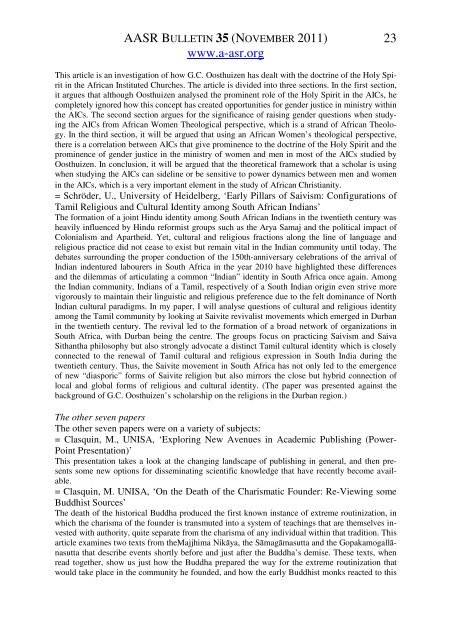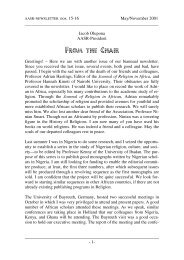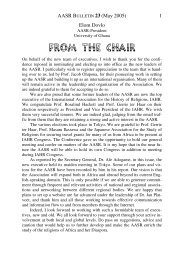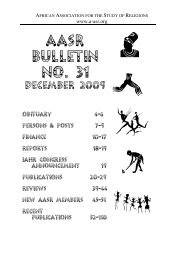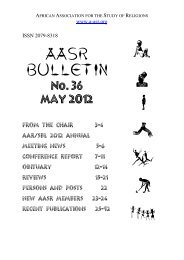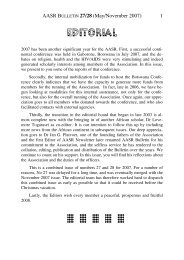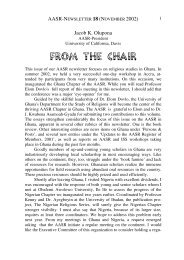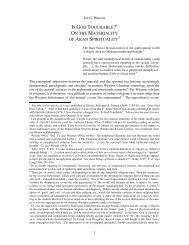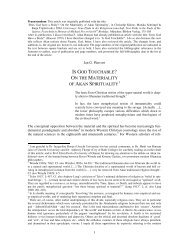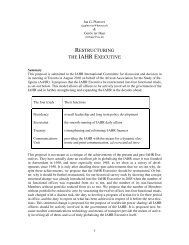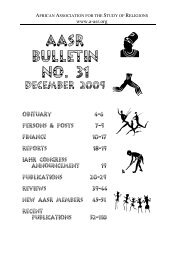AASR Bulletin 35 - The African Association for the Study of Religions
AASR Bulletin 35 - The African Association for the Study of Religions
AASR Bulletin 35 - The African Association for the Study of Religions
You also want an ePaper? Increase the reach of your titles
YUMPU automatically turns print PDFs into web optimized ePapers that Google loves.
<strong>AASR</strong> BULLETIN <strong>35</strong> (NOVEMBER 2011)<br />
www.a-asr.org<br />
23<br />
This article is an investigation <strong>of</strong> how G.C. Oosthuizen has dealt with <strong>the</strong> doctrine <strong>of</strong> <strong>the</strong> Holy Spirit<br />
in <strong>the</strong> <strong>African</strong> Instituted Churches. <strong>The</strong> article is divided into three sections. In <strong>the</strong> first section,<br />
it argues that although Oosthuizen analysed <strong>the</strong> prominent role <strong>of</strong> <strong>the</strong> Holy Spirit in <strong>the</strong> AICs, he<br />
completely ignored how this concept has created opportunities <strong>for</strong> gender justice in ministry within<br />
<strong>the</strong> AICs. <strong>The</strong> second section argues <strong>for</strong> <strong>the</strong> significance <strong>of</strong> raising gender questions when studying<br />
<strong>the</strong> AICs from <strong>African</strong> Women <strong>The</strong>ological perspective, which is a strand <strong>of</strong> <strong>African</strong> <strong>The</strong>ology.<br />
In <strong>the</strong> third section, it will be argued that using an <strong>African</strong> Women’s <strong>the</strong>ological perspective,<br />
<strong>the</strong>re is a correlation between AICs that give prominence to <strong>the</strong> doctrine <strong>of</strong> <strong>the</strong> Holy Spirit and <strong>the</strong><br />
prominence <strong>of</strong> gender justice in <strong>the</strong> ministry <strong>of</strong> women and men in most <strong>of</strong> <strong>the</strong> AICs studied by<br />
Oosthuizen. In conclusion, it will be argued that <strong>the</strong> <strong>the</strong>oretical framework that a scholar is using<br />
when studying <strong>the</strong> AICs can sideline or be sensitive to power dynamics between men and women<br />
in <strong>the</strong> AICs, which is a very important element in <strong>the</strong> study <strong>of</strong> <strong>African</strong> Christianity.<br />
= Schröder, U., University <strong>of</strong> Heidelberg, ‘Early Pillars <strong>of</strong> Saivism: Configurations <strong>of</strong><br />
Tamil Religious and Cultural Identity among South <strong>African</strong> Indians’<br />
<strong>The</strong> <strong>for</strong>mation <strong>of</strong> a joint Hindu identity among South <strong>African</strong> Indians in <strong>the</strong> twentieth century was<br />
heavily influenced by Hindu re<strong>for</strong>mist groups such as <strong>the</strong> Arya Samaj and <strong>the</strong> political impact <strong>of</strong><br />
Colonialism and Apar<strong>the</strong>id. Yet, cultural and religious fractions along <strong>the</strong> line <strong>of</strong> language and<br />
religious practice did not cease to exist but remain vital in <strong>the</strong> Indian community until today. <strong>The</strong><br />
debates surrounding <strong>the</strong> proper conduction <strong>of</strong> <strong>the</strong> 150th-anniversary celebrations <strong>of</strong> <strong>the</strong> arrival <strong>of</strong><br />
Indian indentured labourers in South Africa in <strong>the</strong> year 2010 have highlighted <strong>the</strong>se differences<br />
and <strong>the</strong> dilemmas <strong>of</strong> articulating a common “Indian” identity in South Africa once again. Among<br />
<strong>the</strong> Indian community, Indians <strong>of</strong> a Tamil, respectively <strong>of</strong> a South Indian origin even strive more<br />
vigorously to maintain <strong>the</strong>ir linguistic and religious preference due to <strong>the</strong> felt dominance <strong>of</strong> North<br />
Indian cultural paradigms. In my paper, I will analyse questions <strong>of</strong> cultural and religious identity<br />
among <strong>the</strong> Tamil community by looking at Saivite revivalist movements which emerged in Durban<br />
in <strong>the</strong> twentieth century. <strong>The</strong> revival led to <strong>the</strong> <strong>for</strong>mation <strong>of</strong> a broad network <strong>of</strong> organizations in<br />
South Africa, with Durban being <strong>the</strong> centre. <strong>The</strong> groups focus on practicing Saivism and Saiva<br />
Sithantha philosophy but also strongly advocate a distinct Tamil cultural identity which is closely<br />
connected to <strong>the</strong> renewal <strong>of</strong> Tamil cultural and religious expression in South India during <strong>the</strong><br />
twentieth century. Thus, <strong>the</strong> Saivite movement in South Africa has not only led to <strong>the</strong> emergence<br />
<strong>of</strong> new “diasporic” <strong>for</strong>ms <strong>of</strong> Saivite religion but also mirrors <strong>the</strong> close but hybrid connection <strong>of</strong><br />
local and global <strong>for</strong>ms <strong>of</strong> religious and cultural identity. (<strong>The</strong> paper was presented against <strong>the</strong><br />
background <strong>of</strong> G.C. Oosthuizen’s scholarship on <strong>the</strong> religions in <strong>the</strong> Durban region.)<br />
<strong>The</strong> o<strong>the</strong>r seven papers<br />
<strong>The</strong> o<strong>the</strong>r seven papers were on a variety <strong>of</strong> subjects:<br />
= Clasquin, M., UNISA, ‘Exploring New Avenues in Academic Publishing (Power-<br />
Point Presentation)’<br />
This presentation takes a look at <strong>the</strong> changing landscape <strong>of</strong> publishing in general, and <strong>the</strong>n presents<br />
some new options <strong>for</strong> disseminating scientific knowledge that have recently become available.<br />
= Clasquin, M. UNISA, ‘On <strong>the</strong> Death <strong>of</strong> <strong>the</strong> Charismatic Founder: Re-Viewing some<br />
Buddhist Sources’<br />
<strong>The</strong> death <strong>of</strong> <strong>the</strong> historical Buddha produced <strong>the</strong> first known instance <strong>of</strong> extreme routinization, in<br />
which <strong>the</strong> charisma <strong>of</strong> <strong>the</strong> founder is transmuted into a system <strong>of</strong> teachings that are <strong>the</strong>mselves invested<br />
with authority, quite separate from <strong>the</strong> charisma <strong>of</strong> any individual within that tradition. This<br />
article examines two texts from <strong>the</strong>Majjhima Nikāya, <strong>the</strong> Sāmagāmasutta and <strong>the</strong> Gopakamogallānasutta<br />
that describe events shortly be<strong>for</strong>e and just after <strong>the</strong> Buddha’s demise. <strong>The</strong>se texts, when<br />
read toge<strong>the</strong>r, show us just how <strong>the</strong> Buddha prepared <strong>the</strong> way <strong>for</strong> <strong>the</strong> extreme routinization that<br />
would take place in <strong>the</strong> community he founded, and how <strong>the</strong> early Buddhist monks reacted to this


